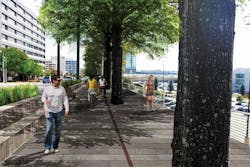Across the U.S., and particularly in the South, major urban arterials have historically dissected communities, displaced pedestrians, and created real barriers to modern urbanism.
Increasingly, city leaders are rethinking public infrastructure and seeking ways to reclaim urban streets for all users. The modern family and its changing demographics are demanding more livable communities and walkable urbanism. The traditional two-parent, two-child household in the suburbs is morphing into non-traditional households that value urban living and compact, walkable places. According to the 2017 Community and Transportation Preference Survey by the National Association of Realtors, “Walkability, a short commute, and proximity to the highway are top priorities—over seven out of 10 residents say those qualities are very or somewhat important in deciding where to live.” The tide is turning towards valuing cities and walkable communities, for millennials fresh out of school, parents with children, and baby boomer empty-nesters.
The Lenox Boardwalk will transform into a wide boardwalk that extends from the curb to the back of the existing retaining wall.
Handling the new normal
How can communities across the nation take existing infrastructure and transform it into a system that meets the demands of this “new normal?” Urban planners and designers note 10 key elements to keep in mind when looking to transform arterial corridors into thriving, functioning micro-communities:
- Reposition/regenerate the neighborhoods;
- Leverage public investment;
- Change the rules to change the form;
- Reduce parking requirements;
- Create streets and blocks;
- Retrofit existing sites for sustainability;
- Fix the infrastructure;
- Think multimodal;
- Look for low-cost, high-visibility and high-impact changes first; and
- Create partnerships.
A mock-up of how the Lenox Road corridor could look with improvements.
Revitalizing a corridor
Lenox Road in the Buckhead community of Atlanta is an anomaly. It is a roadway that currently does not reflect the upscale, bustling needs of the neighborhoods surrounding it. Portions of the road are designed to be a highway, while other segments are dated, lacking maintenance, lighting and pedestrian connectivity. The Buckhead community has seen tremendous change over the past 15 years. New development, new businesses, more residents, improved transportation options and updated streetscapes all reflect this change. For many years, reimagining Peachtree Road has been the focus of the Buckhead Community Improvement District (BCID). Now the BCID (along with its partners the city of Atlanta and the Georgia Department of Transportation [GDOT]) has turned its attention to Lenox Road, a heavily traveled corridor that lacks pedestrian amenities and is dominated by automobiles. Lenox Road is a Buckhead-only corridor and has the potential to become a signature street able to compete with other significant corridors around the world. But first, how does the community select from the 10 key elements above to jumpstart real change?
Buckhead CID engaged international consulting firm Stantec Inc. and Perez Planning & Design to provide a corridor study for Lenox Road to identify short-term and long-term opportunities to create equity for all users (pedestrian and vehicular). The study addresses operational improvements and aims to improve access to and from Georgia S.R. 400 and capitalize on the ongoing “Park Over 400.” The park project will create a significant greenspace/park amenity and bike/ped thoroughfare over GA 400 and MARTA’s Buckhead Station, connecting the Atlanta Financial Center and Lenox Road/Buckhead Loop. Keeping this in mind, Buckhead CID is focusing first on improving the pedestrian and bicycle network along Lenox Road with expanded sidewalks/multi-use trails/sidepaths; new streetscape improvements to mirror the aesthetics of the widely admired Peachtree Road; and operational improvements at the S.R. 400 interchange to allow for safe pedestrian/bicycle crossings.
One recommendation for the Lenox Road project is to expand the road network and connect the roads into a better grid.
Smart borrowing
The Lenox Road Corridor Study team drew on elements from other iconic corridors such as Michigan Avenue in Chicago. With 150-ft building-face to building-face, six travel lanes, and 40,000-46,000 vehicles per day, carefully crafted design details are emphasized to humanize the space. To make this major arterial more pedestrian-friendly, Chicago focused on equity for all users and added streetscape elements like street trees, wide sidewalks, landscaped medians, safe intersections and street-oriented development.
Exhibition Road in London is another acclaimed corridor. This street is 120 ft building-face to building-face, with four travel lanes carrying 36,000-39,000 vehicles per day. A curbless street section was introduced into the design creating a “shared street” concept that was reinforced with seating, street trees, textured pavement and public art. These two examples represented best practices that were brought to the table when discussing Lenox Road.
In contrast to these signature streets, the Lenox corridor accommodates more than 50,000 cars daily, lacks a supporting street grid, and has only one interchange for access into and out of the community. With the goal of transforming the corridor into a strong, functioning, attractive urban street that enhances the Atlanta experience, the city of Atlanta, GDOT, Buckhead CID, and Livable Buckhead (among other stakeholders) are invested in spearheading a revitalization of this entire corridor to include not only Lenox Road, but the Park Over 400 and the S.R. 400 Interchanges Feasibility Study. Although different projects, they all support Lenox Road’s healthy future as a complete, living organism.
If Lenox Road is a living entity, then the capillaries are the side streets and road networks supporting it. Currently, side streets are either underdeveloped, do not function properly or are under-used (e.g. S.R. 400). Bottom line: For the major thoroughfare that is Lenox Road to be healthy and function properly, it needs a strong, efficient support network.
The Lenox Road corridor project has been divided into three uniquely different “character areas” that share an overall design theme.
Planning it out
Since Lenox Road is one of the major roads providing access to and from the Buckhead community, level of service is a critical consideration. The design study team knew widening the road was not an option, because it would increase vehicular traffic while undercutting the central desire to increase walkability.
The project team developed several alternatives for movement within this corridor using complete streets concepts. The alternatives looked at elements that would encourage pedestrian and bicycle movement to alleviate vehicle congestion. After a community-wide charrette and multiple stakeholder meetings the team developed four recommendations that would improve this roadway’s health and viability.
1. Expand the road network. Examine how to expand the roads and connect them into a better grid. This includes expanding the pedestrian network, expanding the trail network beyond PATH 400 (think system not spine), and begin thinking of the corridor in the context of a larger, dynamic network. Of note, PATH 400 is a multi-use greenway trail under construction along the S.R. 400 tollway in Buckhead. Once complete, the trail will be 10 ft to 14 ft wide and traverse the cities of Atlanta, Sandy Springs and Dunwoody.
2. Humanize the intersections. Eliminate free-flow right turns and install high-quality intersections.
3. Rationalize the traffic. Reduce travel lanes to 10 ft and reduce the speed limit to 35 mph.
4. Beautify and activate. Install/coordinate signage and wayfinding, install a world-class streetscape, and construct wide pedestrian promenades and protected bike facilities.
Due to the length and complexity of the Lenox Road corridor and surrounding developments, the project has been divided into three “character areas” that will be uniquely different from one another but share an overall design theme that encompasses the entirety of the project: Piedmont Road to S.R. 400, S.R. 400 to Peachtree Road and Peachtree Road to East Paces Ferry Road.
Portions of the existing Lenox Road are designed to be a highway, while other segments are dated, lacking maintenance, lighting and connectivity.
Character areas
Piedmont Road to S.R. 400: The existing sidewalk from Piedmont Road to Tower Place will be expanded, and a wider vegetative buffer will be added. PATH 400 will remain along the north side of Lenox Road with a slightly larger buffer due to the change from curb and gutter to header curb. A new trail/side-path will be added along the south side from Tower Place to S.R. 400 adjacent to the parking lot of the existing retail development.
S.R. 400 to Peachtree Road: The S.R. 400 interchange will be updated to serve as a gateway that includes new pedestrian connections, high-end detailing and architectural lighting. New trails will run along both sides of Lenox Road with the primary trail running along the north side of the road before crossing Lenox at Phipps Boulevard and continuing along the south side. A new staircase and ramp will be added from the trail to Henry Aaron Alexander Plaza for pedestrian access.
Peachtree Road to East Paces Ferry Road: This section strengthens the urban character of Lenox Road. To take advantage of the existing views of Buckhead and Lenox Mall, the trail (known as the Lenox Boardwalk) will transform into a wide boardwalk that extends from the curb to the back of the existing retaining wall. Granite curbing and raised planters will accent the corridor. The west side will include streetscape improvements.
Performance metrics are another key aspect of this project. For example, if a goal is to increase the tree canopy by 70%, this constitutes a real quantitative measurement. The design team held themselves to certain metrics but endeavored to remove “level of service” from the discussion. Why? Level of service focuses on traffic congestion and delay times, essentially traffic-engineering concepts. Although level of service is important to consider as a baseline, it never tells the complete story. If you redesign a corridor to generate more street-level activity, an environment is created where people want to stop, walk and enjoy the space. The corridor then can be viewed from a placemaking perspective, a radically different approach to traditional level-of-service metrics.
Many preliminary ideas have already taken root from the Lenox Road Corridor Study. They include:
- Over $5 million has been dedicated to the Lenox Boardwalk;
- A housing study is underway to address equity;
- PATH 400 continues to expand northward;
- Redevelopment is beginning as several properties have been purchased with plans for new uses; and
- A new interchange is being studied near Lenox Mall.
Why is the Lenox Road study important for the local Buckhead community? The simple answer is that communities in “pain” frequently offer the greatest opportunity for change. Lenox Road has opened an important discussion around changing how engineers, designers, planners and city agencies look at major roadways, pushing them to consider the complete network. It signifies that now is the time to begin thinking about streets as living organisms, ones that can thrive only if there are healthy support networks, including pathways, sidewalks, side roads and amenities.
For many years, the reimagining of Peachtree Road was the focus of the Buckhead Community Improvement District, which is now making improvements along Lenox Road.



